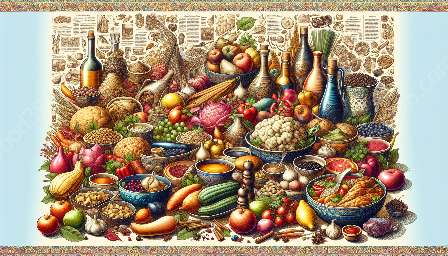In the history of human civilization, the development of irrigation systems has played a crucial role in the advancement of food production. From the earliest agricultural practices to the modern technologies used in farming today, the evolution of irrigation and food production has been a testament to human ingenuity and resourcefulness. This topic cluster explores the fascinating journey of how irrigation systems and food production have evolved over time, as well as their significance in shaping food cultures.
Early Agricultural Practices and the Development of Food Cultures
The story of irrigation systems and food production begins with the dawn of agriculture. Early agricultural practices were characterized by the cultivation of crops and the domestication of animals, marking a pivotal shift in human history from hunter-gatherer societies to settled farming communities. The need for reliable access to water for crops led to the creation of rudimentary irrigation systems, such as simple ditches and canals, to channel water from natural sources.
As these early agricultural practices evolved, so too did the development of food cultures. The availability of water through irrigation allowed for the cultivation of a wider variety of crops, leading to diverse diets and culinary traditions within different communities. The development of food cultures became intricately linked with the availability of water and the success of irrigation systems, shaping the ways in which people grew, prepared, and consumed food.
Origin and Evolution of Food Culture
It is impossible to discuss the evolution of irrigation systems and food production without delving into the origin and evolution of food culture. As agricultural practices and irrigation systems advanced, the cultivation of different crops and the abundance of food resources led to the emergence of distinct food cultures around the world. From the rice-based cuisines of Asia to the grain-centric diets of the Middle East, food cultures developed in harmony with the irrigation systems that sustained them.
Over time, the exchange of agricultural knowledge and the spread of irrigation technologies contributed to the diversity of food cultures, as different regions adapted and innovated in response to their unique environmental conditions. The development of sophisticated irrigation methods, such as the use of aqueducts and terraced fields, further influenced the types of crops that could be cultivated and the culinary traditions that emerged within each society.
The Evolution of Irrigation Systems and Food Production
As human societies continued to progress, so too did the evolution of irrigation systems and food production. Ancient civilizations, such as the Mesopotamians and the Egyptians, are renowned for their engineering feats in creating elaborate irrigation networks that allowed for the flourishing of agriculture in arid regions. These early innovations paved the way for the development of more efficient irrigation systems, including the use of water wheels and irrigation canals, which significantly increased food production and contributed to the growth of urban centers.
The spread of agricultural knowledge across cultures and continents also led to the exchange of farming techniques and the adaptation of irrigation systems to suit varying geographical conditions. From the terraced rice paddies of Southeast Asia to the qanat systems of Persia, the diversity of irrigation methods reflected the ingenuity of human societies in harnessing water resources for food production. The evolution of irrigation systems was not only a testament to human technological advancement but also a reflection of the cultural and ecological diversity of food production around the world.
Modern Innovations in Irrigation and Food Production
In the modern era, the evolution of irrigation systems and food production has continued to be a story of innovation and adaptation. The development of advanced irrigation technologies, such as drip irrigation and center pivot systems, has revolutionized the way in which water is distributed to crops, maximizing efficiency and sustainability. These innovations have played a critical role in meeting the food demands of a growing global population while minimizing the environmental impact of agricultural practices.
Furthermore, the integration of technology in food production, such as precision farming and hydroponics, has expanded the possibilities for cultivation and has led to the emergence of new food cultures centered around urban agriculture and vertical farming. The evolution of irrigation systems and food production continues to be interconnected with the development of food cultures, as technological advancements shape the ways in which food is grown, distributed, and consumed.
Conclusion
The evolution of irrigation systems and food production is a rich tapestry that weaves together the history of human civilization, early agricultural practices, the development of food cultures, and the origin and evolution of food culture. The story of how irrigation systems have shaped food production and food cultures is a testament to the creativity, resilience, and adaptability of human societies in harnessing the resources of the natural world to sustain themselves. As we look to the future, the continued evolution of irrigation systems and food production will undoubtedly be a driving force in shaping the way we cultivate and appreciate food in the years to come.


